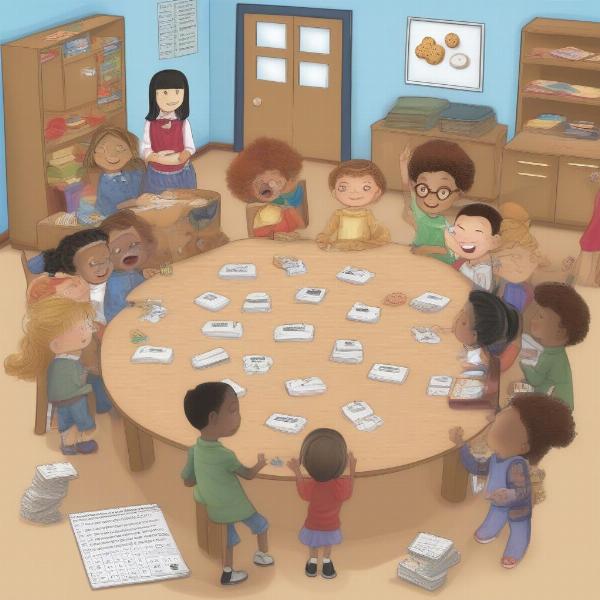The “Who Stole the Cookie from the Cookie Jar” game is a classic children’s activity enjoyed for generations. But beyond its simple fun, this game offers valuable lessons in social interaction, language development, and even a bit of playful deception. Let’s explore the history, variations, and benefits of this timeless game.
The Origins and Evolution of the Cookie Jar Game
While the exact origins remain a mystery, the “Who Stole the Cookie from the Cookie Jar” game likely emerged from oral traditions and folk songs. Its simple structure and repetitive lyrics make it easy to learn and adapt, contributing to its widespread popularity. Over time, the game has evolved, spawning various versions and adaptations, each adding unique twists to the core gameplay. From simple family gatherings to elaborate classroom activities, the cookie jar game continues to entertain and engage children across cultures.
The Classic Gameplay: How to Play “Who Stole the Cookie from the Cookie Jar”
The traditional version involves a group sitting in a circle. One person is chosen as the “guesser” and leaves the room. While they’re gone, the group decides who “stole the cookie.” The guesser returns and begins asking each person, “Who stole the cookie from the cookie jar?” Each person, regardless of their guilt or innocence, responds with “Who, me?” The guesser continues questioning, trying to detect subtle clues in body language or tone of voice. The game continues until the cookie thief is identified, or the guesser gives up.
 Children Playing Cookie Jar Game in a Circle
Children Playing Cookie Jar Game in a Circle
Beyond the Basics: Variations and Adaptations
The beauty of the cookie jar game lies in its adaptability. It can be modified to fit different age groups, group sizes, and even educational settings. Some versions incorporate physical actions, like passing a beanbag representing the “cookie.” Others introduce more complex questioning strategies, encouraging critical thinking and deduction skills. Even the “cookie” itself can be changed to reflect different themes or interests, adding a layer of personalization to the game.
Incorporating the Game into Educational Settings
Educators have cleverly adapted the cookie jar game for classroom use. It can be a fun way to practice vocabulary, reinforce grammar rules, or even teach social skills. By changing the “cookie” to a specific vocabulary word or grammatical structure, teachers can engage students in a playful learning environment. The game also provides opportunities for children to practice taking turns, listening attentively, and expressing themselves clearly.
 Classroom Adaptation of the Cookie Jar Game
Classroom Adaptation of the Cookie Jar Game
The Benefits of Playing “Who Stole the Cookie from the Cookie Jar”
Beyond its entertainment value, the cookie jar game offers several developmental benefits for children. It helps improve social interaction skills, encourages language development, and fosters a sense of community. The game also provides a safe space for children to explore concepts of deception and honesty in a playful, non-threatening context.
Developing Social Skills and Language Through Play
The game encourages children to observe and interpret social cues, such as facial expressions and tone of voice. This helps them develop their social intelligence and understanding of non-verbal communication. The repetitive nature of the game reinforces language skills, particularly vocabulary and sentence structure. The act of asking and answering questions also promotes conversational skills and active listening.
“The cookie jar game is a fantastic tool for social and emotional learning,” says renowned child psychologist Dr. Emily Carter. “It teaches children valuable lessons about communication, cooperation, and understanding social dynamics.”
Building a Sense of Community and Fun
The shared experience of playing the cookie jar game creates a sense of community and belonging. The laughter and playful banter foster positive relationships and strengthen bonds between children. It’s a simple yet effective way to create a fun and engaging atmosphere in any setting.
“In my years of working with children, I’ve seen firsthand the positive impact of simple games like ‘Who Stole the Cookie from the Cookie Jar,'” adds Dr. Sarah Miller, a leading expert in early childhood development. “These games provide a platform for children to connect, interact, and build lasting memories.”
 Family Playing Cookie Jar Game
Family Playing Cookie Jar Game
Other Fun Circle Games for Kids
There are many other enjoyable circle games that kids can play, offering similar benefits in terms of social interaction and language development. These include:
- Duck, Duck, Goose
- Red Rover
- Ring Around the Rosie
- Hot Potato
Conclusion
The “Who Stole the Cookie from the Cookie Jar” game remains a timeless classic for a reason. It’s a simple, fun, and engaging activity that offers numerous benefits for children’s development. Whether played in a classroom, at a family gathering, or simply among friends, the cookie jar game continues to bring joy and laughter to generations of children. So gather around, get ready to point fingers, and let the playful accusations begin!
FAQ
- What age is the cookie jar game appropriate for? The game is suitable for children of all ages, but it’s particularly popular with preschoolers and elementary school children.
- Can the game be played with just two people? While traditionally played in a group, the game can be adapted for two players.
- What are some other variations of the game? Some variations involve passing an object representing the “cookie” or using different questioning strategies.
- What are the educational benefits of the game? The game enhances social skills, language development, and promotes active listening.
- Can the game be used in a classroom setting? Yes, teachers often use the game to teach vocabulary, grammar, and social skills.
- What other games are similar to the cookie jar game? Similar games include Duck, Duck, Goose, Red Rover, and Hot Potato.
- Where can I find more information about children’s games? Numerous online resources and books offer information about children’s games and their benefits.

